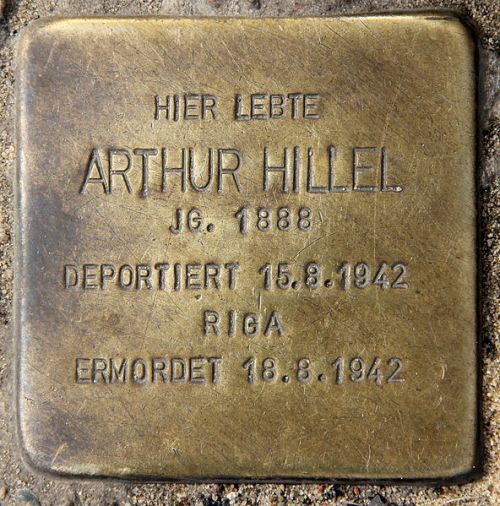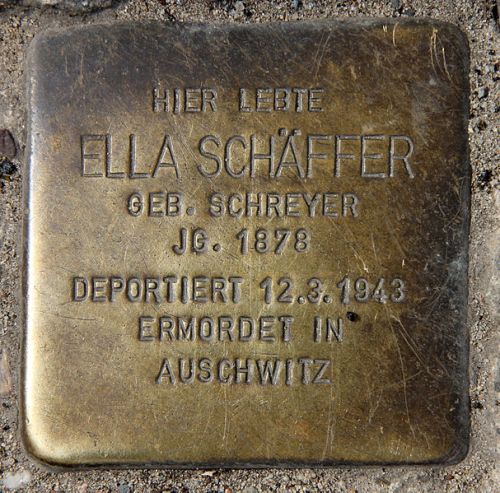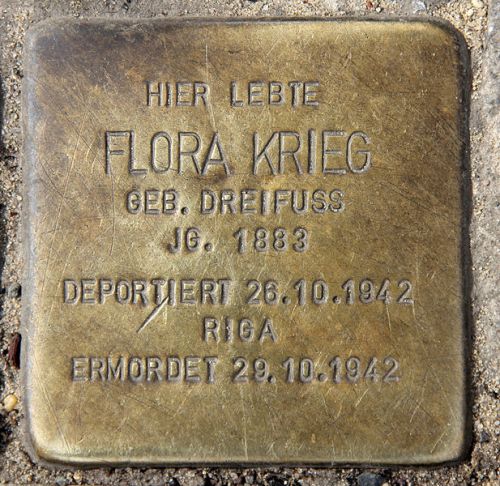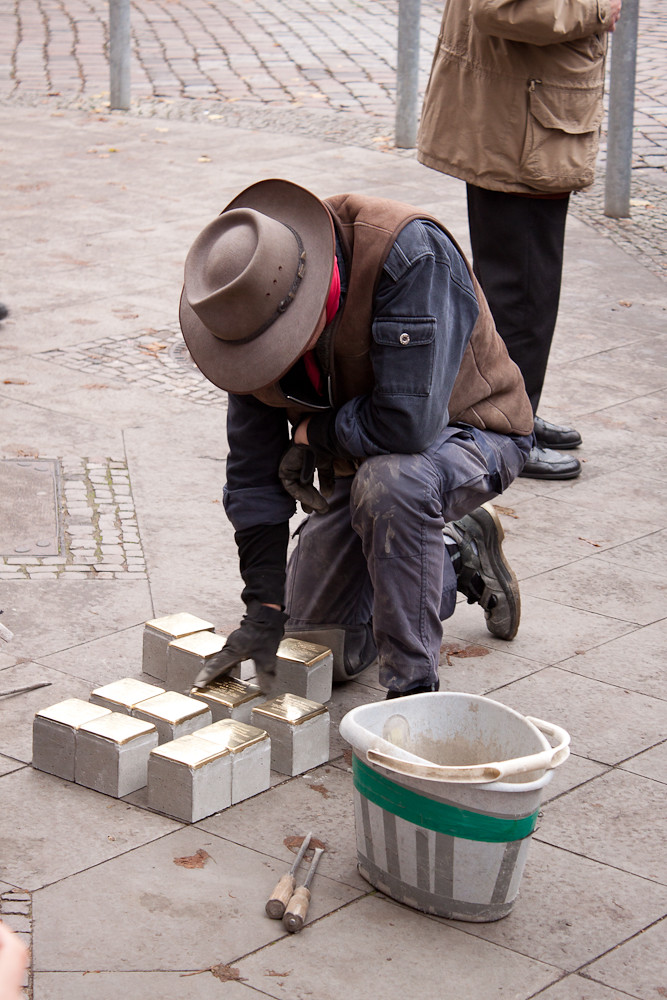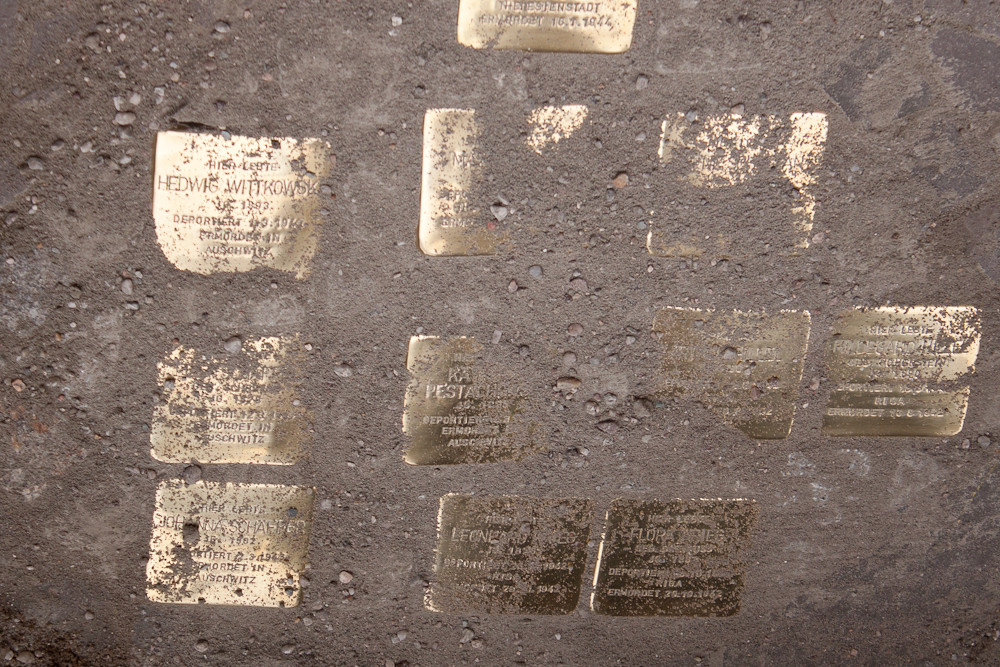Stumbling Stones Hobrechtstraße 57
These small, brass, memorial plaques (Stolpersteine or stumbling stones) commemorate 11 people who lived here. At the top of each stolperstein at this address are the words, "Hier lebte" (Here lived).
* Hedwig Wittkowski, born 1893, deported 1 March 1943, murdered in Auschwitz.
No information was found about Hedwig’s life other than that she was a German citizen. She was deported on Transport 31 from Berlin to Auschwitz along with approximately 1,500 Jewish men, women, and children, packed into closed cattle cars. The train arrived the next day. Only 150 men were selected for labor. The other 1,350 on that train were sent to the gas chambers at Auschwitz Birkenau.
* Ella Schäffer née Schreyer, born 1878, deported 12 March 1943, murdered in Auschwitz.
* Johanna Schäffer, born 1902, deported 2 March 1943, murdered in Auschwitz.
Regarding Ella and Johanna Schäffer, almost no information was found on their lives or on the relationship between them. One source gives their permanent address as Wassertorstrasse 34, Kreuzberg. The younger Johanna was deported first – on Transport 32 with approximately 1,500 others, of whom only 26 are known to have survived. Ella Schäffer was deported 10 days later on Transport 36.
* Käte Pestachowski, born 1905, deported 4 March 1943, murdered in Auschwitz.
Almost no information was found about Käte Pestachowski’s life. Her parents died before WW1; her brother in 1920. Käte was a German citizen with a permanent address of Halensee in Berlin-Wilmersdorf. She was deported on Transport 34 from Berlin, in closed cattle cars with 1,120 Jewish men, women, and children. They arrived in Auschwitz 2 days later. Sent directly to the gas chambers were 643 deportees. Selected for forced labor were 389 men and 200 women. Only 14 from this train are known to have survived. Käte’s sister Alice Muench survived the war but died in early 1950, possibly by suicide.
* Arthur Hillel, born 1888, deported 15 August 1942, Riga, murdered 18 August 1942.
* Hildegard Hillel nee Hohenstein, born 1890, deported 15 August 1942, Riga, murdered 18 August 1942.
Arthur and Hildegard Hillel were husband and wife. They lived in at least two other places before arriving here in 1938, where they lived in 2 rooms that they rented from Leonhard Krieg. The couple were forced to work – Arthur as a machinist in the Arms and Munitions Factory in Borsigwalde, and Hildegard in the J. D. Riedel chemical company in Britz. He earned 95 pfennigs an hour, and she 47 pfennigs. On 15 August 1942 they were deported to Riga in a train carrying about 1000 Jews. Soon after arriving at the Riga station, the deportees were murdered in the forests. The Hillels were declared dead 3 days later.
* Max Fischel, born 1871, deported 23 September 1942, Theresienstadt, murdered 8 December 1942.
Very little was found about Max Fischel’s life. His death certificate shows that he had 3 brothers also at Theresienstadt in 1942: one was deported to Treblinka in September, one was killed in Theresienstadt on 24 December 1942, and the fate of the third is not known.
* Irene Schiftan, born 1922, deported 4 August 1943, murdered in Auschwitz.
Irene Schiftan was living with her parents in Köpenicker Straße 183 in Kreuzberg, Berlin, when in early January 1941, she was drafted into forced labor at the Ehrich & Graetz metal and electrical company in Berlin-Treptow until 19 January 1943. On 15 February 1942, Irene’s 71-year-old mother was arrested and sent to Theresienstadt.
* Marie Schlesinger née Schweitzer, born 1864, deported 29 October 1942, Theresienstadt, murdered 16 January 1944.
Very little was found about Marie Schlesinger’s life or marriage. She was deported on the 73rd of 123 transports taking mostly elderly Jewish deportees from Berlin to Theresienstadt. This transport carrying 64 women and 36 men ages 8-93. Only 9 deportees are known to have survived the war. The website, holocaust.cz, gives a different year of birth (1868) with all other information the same as found in Yad Vashem and states that Marie Schlesinger was murdered in Theresienstadt.
* Leonhard Krieg, born 1878, deported 26 October 1942, Riga, murdered 29 October 1942.
* Flora Krieg née Dreifuss, born 1883, deported 26 October 1942, Riga, murdered 29 October 1942.
Leonhard Krieg and Flora Dreifuss, both German citizens, married but apparently had no children. Three of Leonhard’s siblings escaped to Australia or Venezuela; one was murdered in Auschwitz. Nothing was found about Flora Krieg’s life or family.
"Stolpersteine" is an art project for Europe by Gunter Demnig to commemorate victims of National Socialism (Nazism). Stolpersteine (stumbling stones) are small, 10x10cm brass plaques placed in the pavement in front of the last voluntary residence of (mostly Jewish) victims who were murdered by the Nazis. Each plaque is engraved with the victim’s name, date of birth, and place (mostly a concentration camp) and date of death. By doing this, Gunter Demnig gives an individual memorial to each victim. One stone, one name, one person. He cites the Talmud: "A human being is forgotten only when his or her name is forgotten."
Do you have more information about this location? Inform us!
Source
- Text: Fedor de Vries & Anne Palmer
- Photos: OTFW, Berlin (1), OTFW, Berlin (2), OTFW, Berlin (3), Christoph Flegel (4), Christoph Flegel (5)
- Yad Vashem Central Database of Shoah Victims’ Names
- Geni.com
- USHMM Holocaust Survivors and Victims Database
- Yad Vashem Deportation Database
- holocaust.cz
- Stolpersteine.eu
Nearby
Museum
- Bezirksmuseum Friedrichshain-Kreuzberg - Berlin-Kreuzberg
- Jüdisches Museum Berlin (Jewish Museum Berlin) - Berlin
- Luftschutzraum/Dokumentenbunker Tempelhof - Berlin
Point of interest
- Desinfections Anstalt 1 - Berlin
- Information Panel Destroyed Fraenkelufer Synagogue - Berlijn
- Air-raid Shelter Fichtestraße - Berlin
Monument
- Memorial Benno and Irmgard Heller - Berlin-Neukölln
- Memorial Murdered Scholars Rütli-Oberschule - Berlin-Neukölln
- Memorial Synagogue Kreuzberg - Berlin-Kreuzberg
Cemetery
- Lilienthalstraße German War Cemetery - Berlin
- German War Graves Berlin-Friedrichswerderscher - Berlin
- Garrison Cemetery Columbiadamm - Berlin
Remembrance Stone
- Stumbling Stones Lenaustraße 21 - Berlin-Neukölln
- Stumbling Stone Lenaustraße 6 - Berlin-Neukölln
- Stumbling Stone Pflügerstraße 1 - Berlin-Neukölln
